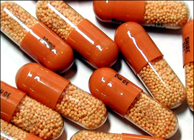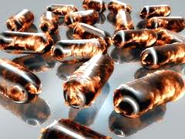Generic Medicines
Taj Pharma is the largest generic pharmaceutical company in India. We hold top positions in different established markets worldwide generics markets..
Amphetamine is a stimulant and an appetite suppressant. It stimulates the central nervous system (nerves and brain) by increasing the amount of certain chemicals in the body. This increases heart rate and blood pressure and decreases appetite, among other effects.
Amphetamine is used to treat narcolepsy and attention deficit disorder with hyperactivity (ADHD).
Amphetamine may also be used for purposes other than those listed in this medication guide.
Health Hazards
Methamphetamine is a powerfully addictive stimulant that dramatically affects the central nervous system. The drug is made easily in clandestine laboratories with relatively inexpensive over-the-counter ingredients. These factors combine to make methamphetamine a drug with high potential for widespread abuse.
Methamphetamine is commonly known as "speed," "meth" and "chalk." In its smoked form, it is often referred to as "ice," "crystal," "crank" and "glass." It is a white, odorless, bitter-tasting crystalline powder that easily dissolves in water or alcohol. It was developed early in this century from its parent drug, amphetamine, and was used originally in nasal decongestants and bronchial inhalers. Methamphetamine's chemical structure is similar to that of amphetamine, but it has more pronounced effects on the central nervous system. Like amphetamine, it causes increased activity, decreased appetite and a general sense of well-being. The effects of methamphetamine can last six-to-eight hours. After the initial rush, there is typically a state of high agitation that in some individuals can lead to violent behavior.
Methamphetamine is classified as a psychostimulant, as are other drugs of abuse
 such as amphetamine and cocaine. We know that methamphetamine is structurally similar to amphetamine and the neurotransmitter dopamine, but it is quite different from cocaine. Although these stimulants have similar behavioral and physiological effects, there are some major differences in the basic mechanisms of how they work at the level of the nerve cell. However, the bottom line is that methamphetamine, like cocaine, results in an accumulation of the neurotransmitter dopamine, and this excessive dopamine concentration appears to produce the stimulation and feelings of euphoria experienced by the user. In contrast to cocaine, which is quickly removed and almost completely metabolized in the body, methamphetamine has a much longer duration of action and a larger percentage of the drug remains unchanged in the body. This results in methamphetamine being present in the brain longer, which ultimately leads to prolonged stimulant effects. It is very important to get the use of this drug stopped. One of the ways to do that is to do regular urine drug testing of the person who is using this drug. Urine drug testing products are available for purchase at Drug Test Kits For AMP
such as amphetamine and cocaine. We know that methamphetamine is structurally similar to amphetamine and the neurotransmitter dopamine, but it is quite different from cocaine. Although these stimulants have similar behavioral and physiological effects, there are some major differences in the basic mechanisms of how they work at the level of the nerve cell. However, the bottom line is that methamphetamine, like cocaine, results in an accumulation of the neurotransmitter dopamine, and this excessive dopamine concentration appears to produce the stimulation and feelings of euphoria experienced by the user. In contrast to cocaine, which is quickly removed and almost completely metabolized in the body, methamphetamine has a much longer duration of action and a larger percentage of the drug remains unchanged in the body. This results in methamphetamine being present in the brain longer, which ultimately leads to prolonged stimulant effects. It is very important to get the use of this drug stopped. One of the ways to do that is to do regular urine drug testing of the person who is using this drug. Urine drug testing products are available for purchase at Drug Test Kits For AMP
Methamphetamine comes in many forms and can be smoked, snorted, orally ingested or injected. The drug alters moods in different ways, depending on how it is taken. People often ingest amphetamines by snorting them through the nostril initially. However, the level of absorption through this form of intake is not as predictable and rapid as injection or smoking).
Immediately after smoking the drug or injecting it, the user experiences an intense rush or flash that lasts only a few minutes and is described as extremely pleasurable. Snorting or oral ingestion produces euphoria, a high but not an intense rush. Snorting produces effects within three-to-five minutes, and oral ingestion produces effects within 15-to-20 minutes.
As with similar stimulants, methamphetamine most often is used in a "binge and crash" pattern. Because tolerance for methamphetamine occurs within minutes -- meaning that the pleasurable effects disappear even before the drug concentration in the blood falls significantly -- users try to maintain the high by bingeing on the drug. In the 1980s, "ice," a smokable form of methamphetamine, came into use. Ice is a large, usually clear crystal of high purity that is smoked in a glass pipe like crack cocaine. The smoke is odorless, leaves a residue that can be re-smoked and produces effects that may continue for 12 hours or more.
Parents can help their children better their health. Monitor them regularly to let them know that you love and care about their health. Parents should invest in their children with the purchase of easy-to-use personal and private urine drug testing kits on a regular basis. Your children’s health depends on your involvement in their prevention and/or recovery from drug use/abuse. You can purchase a simple drug testing kit today to better their future. As an individual and/or parent, go to Drug Test Kits For AMP now to invest in yours and/or your child’s health.
Dosage:
For Narcolepsy:
Common initial dose - 5 mg once or twice daily
Usual maximal dose (carefully monitored higher doses may sometimes be required) - 30 mg am and noon (short-acting, sustained-release or combination)
Overdose
Symptoms: Rapid heartbeat, hyperactivity, high fever, hallucinations, suicidal or homicidal feelings, convulsions, coma.
Effects:
Enhanced mood and body movement
Increased wakefulness, physical activity
Increased respiration
Euphoria
Insomnia
Increased heart rate
Increased blood pressure
Reduced appetite
Cardiovascular collapse, death
Dilated pupils
Complications
According to the National Institute on Drug Abuse Web site, a study in Seattle showed that methamphetamine use was widespread in the homosexual and bisexual community and they reported using the drug when engaging in unsafe sex and unsafe needle-use, leaving them at risk for contracting and transmitting HIV and AIDS.
Meth can be injected with a needle, increasing the chance of contracting HIV/AIDS, hepatitis and other infectious diseases.
Often pure amphetamines are mixed with other substances such as sugar, glucose, bi-carb soda and ephedrine that can be poisonous, causing collapsed veins, tetanus, abscesses and damage to the heart, lungs, liver and brain.
Incessant use might result in addictions to other drugs such as benzodiazepines (a kind of anti-anxiety agent) taken to calm down so the individual can sleep.
Causes
While this class of drugs was initially unregulated, today legal uses are limited to prescription to treat attentional disorders, obesity, narcolepsy and depressive disorders. Causes of amphetamine addiction are largely related to features of the drugs. While the effects are almost immediate, tolerance is built up quickly, thus increasing the amount needed to produce the desired effect. During periods of nonuse, the user will recall the feeling of euphoria produced by the drug and desire to intake it again. According to the DEA, abuse of amphetamines began when they were used as a cure-all to keep people awake, train longer, treat depression and for weight control. According to the National Institute on Drug Abuse, a 2003 study revealed that 6.2 percent of high school seniors reported using methamphetamines at some point in their life, along with 5.3 percent of tenth graders and 3.9 percent of eighth graders. Among high school seniors, 3.2 percent reported methamphetamine use in the past year.
Treatment
At this time the most effective treatments for methamphetamine addiction are cogni tive behavioral interventions. These approaches are designed to help modify the patient's thinking, expectancies and behaviors and to increase skills in coping with various life stressors. Methamphetamine recovery support groups also appear to be effective adjuncts to behavioral interventions that can lead to long-term drug-free recovery.
tive behavioral interventions. These approaches are designed to help modify the patient's thinking, expectancies and behaviors and to increase skills in coping with various life stressors. Methamphetamine recovery support groups also appear to be effective adjuncts to behavioral interventions that can lead to long-term drug-free recovery.
There are currently no particular pharmacological treatments for dependence on amphetamine or amphetamine-like drugs such as methamphetamine. The current pharmacological approach is borrowed from experience with treatment of cocaine dependence. Unfortunately, this approach has not met with much success since no single agent has proven efficacious in controlled clinical studies. Antidepressant medications are helpful in combating the depressive symptoms frequently seen in methamphetamine users who recently have become abstinent. Personal and private amphetamine drug testing is an important part of helping an addict stop their substance abuse.
There are some established protocols that emergency room physicians use to treat individuals who have had a methamphetamine overdose. Because hyperthermia and convulsions are common and often fatal complications of such overdoses, emergency room treatment focuses on the immediate physical symptoms. Overdose patients are cooled off in ice baths, and anticonvulsant drugs may be administered also.
Acute methamphetamine intoxication can often be handled by observation in a safe, quiet environment. In cases of extreme excitement or panic, treatment with anti-anxiety agents such as benzodiazepines has been helpful, and in cases of methamphetamine-induced psychoses, short-term use of neuroleptics has proven successful.)
WARNING
The combination of dextroamphetamine and amphetamine can be habit-forming. Do not take a larger dose, take the medication more often, or take it for a longer time than prescribed by your doctor. If you take too much dextroamphetamine and amphetamine, you may find that the medication no longer controls your symptoms, you may feel a need to take large amounts of the medication, and you may experience symptoms such as rash, difficulty falling asleep or staying asleep, irritability, hyperactivity, and unusual changes in your personality or behavior. Overusing dextroamphetamine and amphetamine may also cause sudden death or serious heart problems such as heart attack or stroke.
Tell your doctor if you or anyone in your family drinks or has ever drunk large amounts of alcohol, uses or has ever used street drugs, or has overused prescription medications. Your doctor will probably not prescribe dextroamphetamine and amphetamine for you.
Do not stop taking dextroamphetamine and amphetamine without talking to your doctor, especially if you have overused the medication. Your doctor will probably decrease your dose gradually and monitor you carefully during this time. You may develop severe depression and extreme tiredness if you suddenly stop taking dextroamphetamine and amphetamine after overusing it.
Do not sell, give away, or let anyone else take your medication. Selling or giving away dextroamphetamine and amphetamine may harm others and is against the law. Store dextroamphetamine and amphetamine in a safe place so that no one else can take it accidentally or on purpose. Keep track of how many tablets or capsules are left so you will know if any are missing.
Your doctor or pharmacist will give you the manufacturer's patient information sheet (Medication Guide) when you begin treatment with dextroamphetamine and amphetamine and each time you get more medication. Read the information carefully and ask your doctor or pharmacist if you have any questions.
